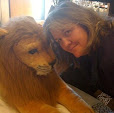What a mild Fall we are having in Colorado. No snow yet, not even on Halloween. I've been slowly putting the garden to bed. Geraniums and begonias are now inside, but the pots of herbs are still on the deck and thriving.
My Christmas cacti are doing their usual pre-Thanksgiving show, which I love, and I'm gearing up to start working on the Civil War quilt again, and toying with the idea of bringing out the puzzle table. The Winter lights are up on the outside of the house, but pumpkins and leaves are still the main decor inside.
I do love the changing seasons. No, I didn't get to see the Northern Lights display last week. Did any of you?
Here's what I've been reading this season:
Run for the Hills, by Kevin Wilson - I finally got my turn for the audio from the library and was not disappointed. It didn't blow me away like Now is Not the Time to Panic, (the other Wilson book I've read and which I gave 5 stars), but it was still fresh and quirky and interesting and moving. Mid-way through, I started seeing it as a Wizard of Oz story, and lo, the narrator ended up spelling that out near the end--and here I thought I was being clever in making the connection. Anyway, I liked all of the weird characters, never understood the psychological misfires of the dad, but loved how the siblings ended up learning to become a family despite him.
Mysteries
Dance of Cranes, by Steve Burrows - #7 in the fabulous birder-murder series. Our UK police detective, Dominic Jejeune is back in his native Canada, implementing a plan to save his girlfriend from a heinous felon who is back on the loose and out for vengeance against those who incarcerated him. As always, I enjoyed the characters, setting, birding, and convoluted mystery immensely. At 392 pages, these are not short books, but such a pleasure to read. So much more than simple whodunits.
The Rising Tide, by Ann Cleeves - #10 in the Vera Stanhope series, and what a treat. Most of the action takes place on and around Lindisfarne, aka Holy Island, off the eastern edge of England, and the plot deals with old friends who reunite every five years to celebrate their decades-old friendship. Great plot, great setting, such fun to read.
Lindisfarne is in the top 10 places I hope to visit in the not-too-distant future, and I love reading about places I've been or plan to visit.
Mrs. Malory: Death of a Dean, by Hazel Holt - I am quickly becoming addicted to this series, and this is #7. I am not reading them in order, which is fine, but as I find them in used bookstores and my library. This time the story has definite Trollope overtones as the Dean of a cathedral is murdered, and Sheila Malory, as a friend of the family, is bent on finding the killer who just may be one of said family! Also, I good bit of it takes place in Stratford, so again, the setting was just marvelous, and again, is a place I've visited.
Bosch Books - I listened to two Harry Bosch detective novels, The Burning Room and The Crossing, #17 and #18 in the series -- both were excellent and read by Titus Welliver, the actor who plays Bosch in the TV series. Very meta but also very good, just cementing him in my brain as Harry.
Witchy Magic
Practical Magic, by Alice Hoffman - After reading and enjoying The Rules of Magic last year, I finally got around to reading Practical Magic. Halfway through I wasn't sure I was liking it, but I did end up enjoying it quite a bit. I know I should watch the movie, and I have read about how the book and movie differ, so fully prepared. And I have almost a year to watch the movie before the sequel, Practical Magic 2, comes out next September.
TV Stuff
We are rewatching the John Adams mini-series with Paul Giamatti and Laura Linney. Last episode is tonight, and then we move on to the new Ken Burns documentary on the American Revolution, which started on PBS last night.
We are also rewatching Never Have I Ever, which is a delightful three-season show with great dialogue and wonderful characters. It's a Mindy Kaling thing, and is funny, touching, and a good palate cleanser before going to bed.
Just finished the current season of The Great British Bakeoff last week and hoping they will have some holiday specials again this year. Every time I watch it, I am inspired to try some of the signature bakes, but then I have a cup of tea and wait for the urge to pass! Hope I am not spoiling this for anyone, but Jasmine is totally amazing!
Still watching the current season of The Amazing Race and making the Romanian mici that were featured in last week's episode for dinner tonight. I think risotto will go well with them.
--------------------------------------
Happy Thanksgiving everyone, whether you celebrate or not! Thanksgiving is just such a perfect holiday. Giving thanks to the universe for the air we breathe just works.












































